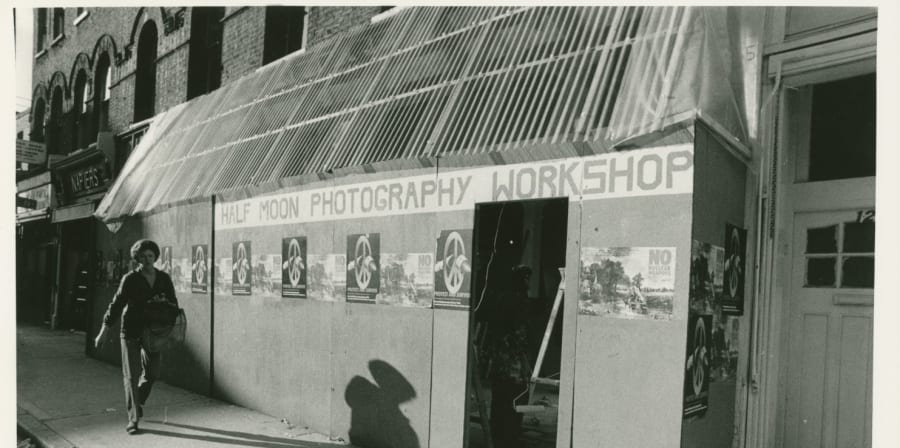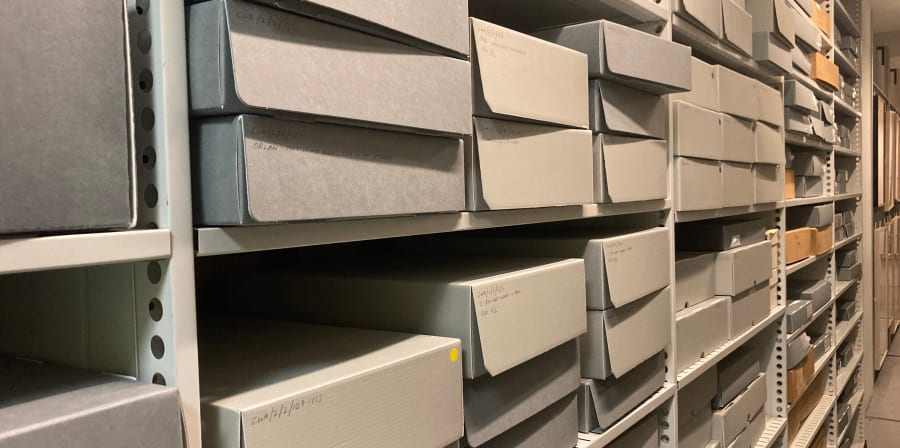The Exhibition
We’re delighted to have loaned some material from the Camerawork Archive for Four Corners’ most recent exhibition, ‘Shuttles, Steam and Soot: A cotton mill in Lancashire’ by Daniel Meadows. The exhibition highlights Meadows’ early photography by recreating a historical 1978 exhibition of the same name, hosted by the Half Moon Photography Workshop, which later changed its name to Camerawork.
The Exhibition presents a detailed portrait of the working lives of weavers (mainly women), engineers, flue cleaners and steeplejacks at the Bancroft Shed in 1975 in the Borough of Pendle in Lancashire. Meadows photographed these workers with great care and attention to their trade, documenting their skilled labour ahead of the mill’s closure in 1978. Also included in the exhibition are three photographs by engineer Stanley Graham, who was inspired by Meadows’ project to create photographs of his own, based on his deep knowledge of the machinery he was working with.
The original 1978 ‘Shuttles, Steam and Soot’ exhibition was an early example of Half Moon’s touring exhibition model that prioritised convenience and affordability to maximise the reach of their exhibitions. Half Moon’s particular innovation for the touring model was its method of display: rather than use expensive printing, mounting and framing, they instead curated exhibition works on laminated card panels, which were secured by four screws in each panel corner. This unique display method made works easy to transport and mount, particularly for smaller galleries and community organisations with fewer resources.
For the first time in nearly thirty years since Half Moon/Camerawork’s closure, this display method has been brought back to life in the Four Corners gallery space. Meadows was eager that the laminated display be recreated for the 2025 version of the exhibition.

Four Corners and Half Moon/Camerawork: Shared visions
Four Corners and Camerawork both emerged out of the 1970s community arts movement and neighboured each other in their Roman Road outposts in the heart of Bethnal Green, East London. Four Corners was formed in 1974 and moved into 113 Roman Road in 1975, creating a space run by filmmakers to train, produce and screen films local to Bethnal Green and its surrounds. Over time, Four Corners came to be known for its training and skill-building opportunities, particularly for artists and filmmakers from non-traditional backgrounds. In 1972, a group of photographers created the Half Moon Gallery in the foyer of the Half Moon Theatre in Alie Street, East London. They formed the Half Moon Photography Workshop, and moved to a new home at 119-121 Roman Road in the late 1970s. The organisation later became known as Camerawork.
Camerawork and its predecessors formed a photographers-led initiative to curate politically engaged touring exhibitions and deliver an educational programme of workshops and seminars. Like Four Corners and filmmaking, Camerawork organised training for local people to use its publicly accessible darkrooms. Camerawork also designed and published Camerawork magazine, which facilitated discourse around photography as a political medium and experimental art form.
Funding cuts led to the eventual closure of Camerawork in the early 2000s. However, in 2003, Four Corners was granted Camerawork’s site by the Arts Council England to reopen the darkrooms and gallery. Today, Four Corners continues to build upon the longstanding visions of these two organisations, hosting exhibitions and programming to continue to support accessible, radical and socially engaged filmmaking and photography practices.

The Camerawork Archive and UAL
In 2006, the Camerawork Archive was donated by Shirley Read, a former member of the Half Moon/Camerawork, to the Photography and the Archive Research Centre (PARC), University of the Arts London (UAL), under the directorship of Professor Val Williams. In 2019, prior to PARC’s 2023 closure, the archive was donated to the UAL Archives and Special Collections Centre as part of a larger deposit of PARC holdings.
The Camerawork Archive contains material charting the history of the touring exhibitions programme, as well as administrative files relating to the running of the organisation from its 1972 opening through to its closure in the early 2000s. Records include prints, exhibition research, correspondence, publicity material, press cuttings, invoices and hire charges.
The material loaned to Four Corners most recently includes publicity material, correspondence and documents relating to touring exhibition hire of Meadows’ 1978 exhibition. It sheds light on the development of exhibition text and traces the touring history of the exhibition across the United Kingdom.
The Archive as a whole offers rich potential for researchers interested in the history of photography, as well as the history of Greater London Authority (GLA)-funded initiatives. In addition, it might support research for those interested in politically-committed interrogations of the photographic medium itself—particularly in the medium’s potential to critically express social demands.
The Four Corners Archive holds material dating to the earlier years of Camerawork, during its earlier years of activity as Half Moon Gallery and Half Moon Photography Workshop (1972-1987). A collection of posters, photographs and administrative documents are also held at the Bishopsgate Institute Special Collections and Archives.

Visiting the Exhibition and the Archive
‘Shuttles, Steam and Soot: A cotton mill in Lancashire’ by Daniel Meadows is open at Four Corners through Saturday 29 March 2025.
- Gallery opening hours are Wednesday – Saturday 11am-6pm.
- Admission is free.
The Camerawork Archive is accessible at the UAL Archives and Special Collections Centre by advanced appointment.
- Appointment slots are available Monday through Friday, 1-4pm.
- Bookings can be arranged via our email archive-enquiries@arts.ac.uk.

